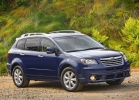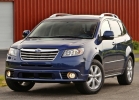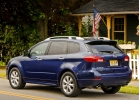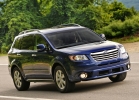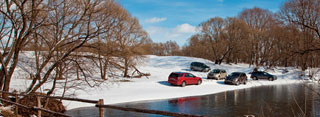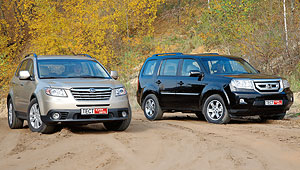Subaru Tribeca test drive since 2007 SUV
Sports for parents
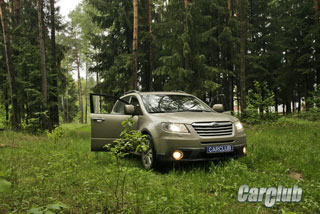 The 2008 model outwardly became much more solid and gained a certain number of years to the already middle -aged target audience.
The 2008 model outwardly became much more solid and gained a certain number of years to the already middle -aged target audience. Recently, the market has become too clearly dictated to manufacturers. Now more than ever the saying is relevant: demand gives birth to a proposal. But are these proposals always appropriate? Or is it better to pay tribute to traditions, not fashion?
Today we will try to deal with this on the example of the flagship model Subaru Tribeca, which has lost the prefix B9 in its name in the restyling process.
I think it is unlikely that anyone needs to talk about the fact that the Japanese Subaru automaker is glorified throughout the world by models of cars, focused on a certain class of people who love a dynamic and very accurate ride, with all the ensuing consequences. Perfectly tuned opposite engines, impeccable chassis and probably, lastly attractive design in their own way. And the age category of the owners of such cars has already been formed and consolidated in a huge army of rather young and loyal fans.
But in 2005, in conditions of hard market ultimatum, Subaru launched its first SUV Tribeca on the conveyor, wanting to declare itself in this so popular and rapidly developing segment. After a three -year experiment, having drawn conclusions, the company displays a restyled version of the tribe to the market.
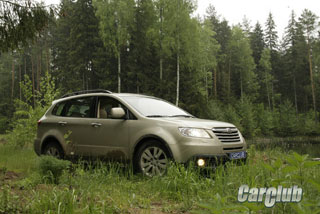 The 2008 model outwardly became much more solid and gained a certain number of years to the already middle -aged target audience. Specific changes have undergone both before and the ass of the car. In front of Tribeca threw the bizarre shape of the radiator grille, which, it would seem, migrated from the previous generation of Impreza WRX, and acquired a new, solid, with longitudinal chrome grill, reaching the trapezoidal anterior optics, also pretty reassured compared to the pre -sustaining machine. As a result, these changes entailed some hood lifting, which also became more even and peaceful.
The 2008 model outwardly became much more solid and gained a certain number of years to the already middle -aged target audience. Specific changes have undergone both before and the ass of the car. In front of Tribeca threw the bizarre shape of the radiator grille, which, it would seem, migrated from the previous generation of Impreza WRX, and acquired a new, solid, with longitudinal chrome grill, reaching the trapezoidal anterior optics, also pretty reassured compared to the pre -sustaining machine. As a result, these changes entailed some hood lifting, which also became more even and peaceful. And the back of the car changed and, in the spirit of innovation of the front, became more restrained: sharp edges on the trunk lid, smoothly turning to the side of the car, were magically smoothed out and from now on are not so striking. In general, in my opinion, the appearance has become more magnificent and does not make the impression of a certain experimental capsule of increased cross -country ability.
And what's inside? It is here that one of the largest inconsistencies begins. Inside, everything remained unchanged by the same space design: a panel, smoothly flowing from one door to another through the central console, with intricate control of climate control, resembling 3 small aquariums. Yes, and the very principle of operation of these regulators is non -standard: they do not spin and do not press, but sway fervently in the left or right side.
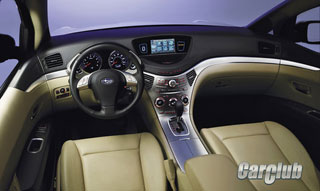 Of course, the number of various kinds of bells and whistles in Tribeca deserves praise. There is a multimedia DVD display for the rear passengers, and the rear view camera with the intellectual construction of the trajectory, and much, much more. But, to say honestly, the connection between a fairly solid appearance and such a playful ultramoded salon, which 100 percent suitable for a more progressive pre-relief model, is not clear.
Of course, the number of various kinds of bells and whistles in Tribeca deserves praise. There is a multimedia DVD display for the rear passengers, and the rear view camera with the intellectual construction of the trajectory, and much, much more. But, to say honestly, the connection between a fairly solid appearance and such a playful ultramoded salon, which 100 percent suitable for a more progressive pre-relief model, is not clear. In terms of technology, the updated Tribeca remains at the same quality level. A modernized 3.6-liter engine that issues 258 horsepower, aggregated by an automatic transmission, has a very low vibration level due to the fact that the structural elements of the motor are well balanced. These parameters add advantages to a comfortable and almost silent movement. You can feel the presence of an engine under the hood from approximately 3,000 thousand revolutions.
But, alas, in the ordinary Drive mode, the engine tandem and the boxes of stars from the sky are not enough. For more gambling, you will have to switch to Sport mode.
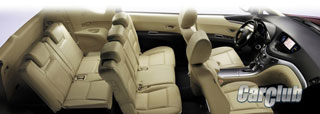 In general, the control of the tribe brings peace, not stress. The power on the steering wheel for any driving modes is always the same. The suspension is quite energy -intensive and in very rare cases will give you to know that the road leaves much to be desired, which, however, does not make it possible to actively steer and attack steep turns.
In general, the control of the tribe brings peace, not stress. The power on the steering wheel for any driving modes is always the same. The suspension is quite energy -intensive and in very rare cases will give you to know that the road leaves much to be desired, which, however, does not make it possible to actively steer and attack steep turns. The impression of a very flat and balanced car without various kinds of claims to super sports in the SUV class is created. And it is rather oriented to people of a more mature age with a good income and a sense of humor for an adequate perception of the internal space.
Dmitry Malygin
The price of the tested car is 1,798,300 rubles
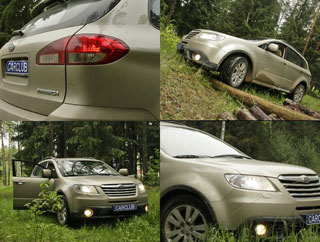
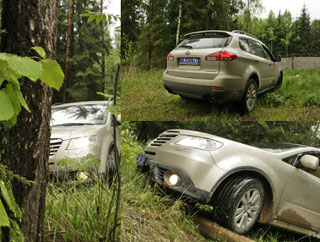
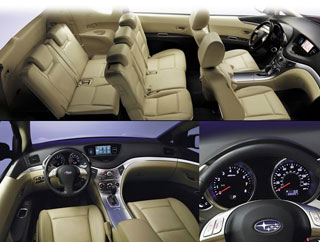
Complete the test of the tested car
Steering with a hydraulic wrap
Steering column adjustable along the angle of inclination
Leather -made wheel
Audiosystem control buttons on the steering wheel
Leather finish of the handle of the selector lever
Cruise control system
Electric windows
Electric drive of the door locks
Casting Remote control system
Safety belt indicator (for the driver)
Premium audio system: CD chamber for 6 CDs and an acoustic system of 9 speakers
DVD navigation system with a 7-inch central display
Rear view chamber system
Entertainment system for rear seats passengers with a 9-inch display
Auditural nest for connecting additional equipment
Double -zone automatic air conditioner system
Individual air cooling system for rear seats passengers
Warming up wind and lateral glasses
The rear window heating with a timer
Air ducts for the rear seats passengers
The system of dynamic stabilization
Ceiling cascading backlight of the selector lever area
Door lighting lamps and lighting lamps of the legs space (for the front seats and seats of the second row)
Sliding sunscreen with accessory mirrors
Branch in the central console with an armrest
Rear sliding department for storing things
Front cup holders with lamps (in the central console)
Rear cup holders (built into the armrest of seats of the second row)
Opening lever from the salon of a gas tank hatch
Sockets for connecting additional electrical equipment at 12 V:
Leather seats
Seats with electroregies (driver seat: in 8 directions, front passenger seat: in 4 directions)
Driver's seat with a 2-position memory function
3-level heating of the front seats
Lumbar support with manual adjustment
The seats of the second row, shifting and leaning in a ratio of 60/40
The seats of the second row, folding in a ratio of 40/20/40
The central armrest of the seats of the second row
Xenon headlights
Leaving the washerers of the headlights
Front fog lights
Folding external mirrors with electric drive and built -in LED rotation indicators
External mirrors with heating
Chrome -made doors
Metal panels of door thresholds (on both sides)
18-inch wheels of aluminum alloy
Glass shifting hatch with electric drive and adjustable inclination
Roof rails
Roof spoiler
Front airbags SRS*4 (with a 2-speed supercharger)
STRIC SRS SRS*4 side pillows (for the driver and passenger of the front seat)
SRS*4 pillows*4 (for the front seats and seats of the second row)
Active head restraints (for the driver and passenger of the front seat)
Front belts of security with parameders and load limiters
Safety belts adjustable in height
Emergency braking
Cipping sensor
ISOFIX system for attaching children's seats (with fasteners)
Rear door locks with children protection mechanisms (on both sides)
Anti -theft security system with engine immobilizer
Specifications
Body
SUV body type (station wagon)
The number of places 5
Equipped mass, kg 1908
Length, mm 4865
Width, mm 1880
Height, mm 1720
Wheel base, mm 2750
Engine
Opposite type, 4-taxant, gasoline
Location in front, transversely
Location and number of cylinders 6 horizontally
Working volume, cm 3630
Cylinder diameter/piston stroke, mm 92.0 x 91.0
The degree of compression is 10.5
The number of valves per cylinder 24
Maximum power, L.S./rpm 258/6000
Maximum torque, Nm/rpm 350/4000
Transmission
Automatic gearbox, Sportshift
Complete drive in the ratio (before 45.7/ ass 54.3
Front suspension Standing suspension of the Macpherson system
Rear suspension suspension on double transverse levers
Front brakes Disco ventilated
Rear brakes Disco ventilated
Tires 255/55R18
Dynamics
Maximum speed, km/h 207
Acceleration time 0-100 km/h, from 8.9
Fuel consumption, l/100 km
city cycle 16.2
country cycle 9
mixed cycle 11.6
Fuel tank capacity, l 64
AI-95 fuel
Source: Carclub.ru

